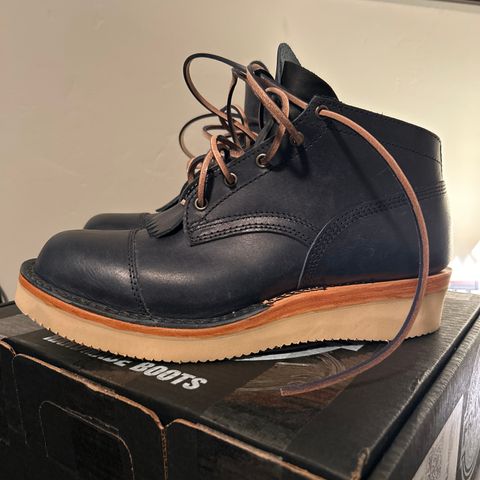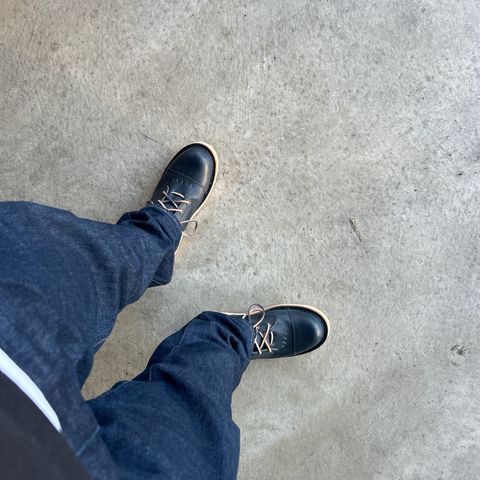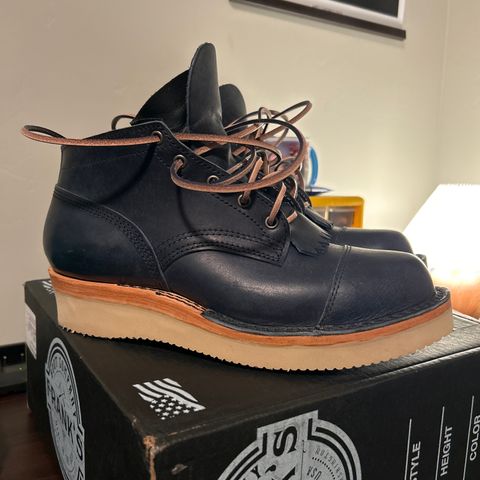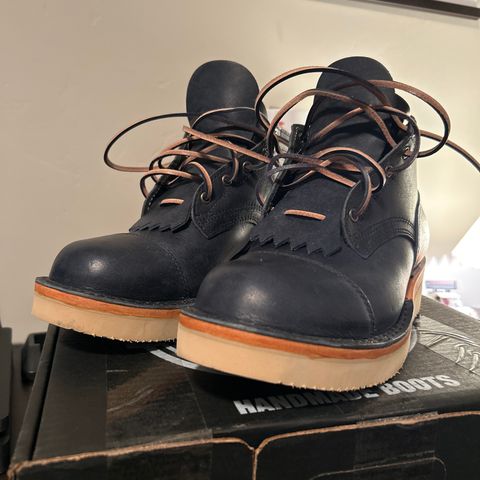About
Badalassi Carlo Navy Pueblo is a color variation of Pueblo leather produced by Badalassi Carlo in San Miniato, Tuscany. The leather features deep navy blue tones achieved through transparent aniline dyeing applied to vegetable-tanned cowhide. Navy Pueblo combines the technical properties of Pueblo leather—including full-grain vegetable tanning, matte stone-ground surface, and rapid patina development—with a classic navy coloration that deepens through wear and aging while maintaining blue undertones.
About
Badalassi Carlo Navy Pueblo is a color variation of Pueblo leather produced by Badalassi Carlo in San Miniato, Tuscany. The leather features deep navy blue tones achieved through transparent aniline dyeing applied to vegetable-tanned cowhide. Navy Pueblo combines the technical properties of Pueblo leather—including full-grain vegetable tanning, matte stone-ground surface, and rapid patina development—with a classic navy coloration that deepens through wear and aging while maintaining blue undertones.
The Navy variation represents a distinctive colorway in the Pueblo range, offering traditional navy blue tones that provide versatility across formal and casual applications. The deep blue coloration creates visual interest compared to standard brown leathers while maintaining professional appearance suitable for business and dress contexts. The transparent aniline dyeing process allows the natural grain and texture of the leather to remain fully visible while providing the navy coloration, combining the characteristic Pueblo surface treatment with classic blue tones.
Color characteristics
Navy Pueblo displays deep blue tones characteristic of traditional navy colorways, ranging from dark blue to midnight blue depending on lighting conditions. The coloration results from transparent aniline dyes applied during Badalassi Carlo's traditional vegetable tanning process, where natural tannins extracted from tree bark are combined with fatliquoring using animal fats inside wooden barrels. The transparent dyeing allows the dye to penetrate completely through the material from grain to flesh side rather than remaining only on the surface.
The vegetable tanning foundation contributes to the color's depth and richness, as the tannins interact with the collagen structure of the hide beneath the navy dye. This underlying structure becomes visible through wear, with flexed and creased areas showing tonal variation as the leather's pull-up characteristics reveal lighter blue or grayish-blue undertones. The full-grain leather maintains visibility of natural marks present in the cowhide, appearing as variations in surface texture and subtle color differences.
Natural marks present in the steerhide remain somewhat visible in Navy Pueblo despite the dark coloration, appearing as variations in dye absorption and surface texture. These variations—including scratches, wrinkles, and grain patterns—integrate into the overall navy appearance and become more pronounced as the leather ages and high-wear areas develop shine. The stone-ground surface treatment creates a matte, slightly textured finish that adds depth to the navy color and prevents it from appearing flat. Color consistency within production batches follows natural variation typical of vegetable-tanned leather, with the navy base providing substantial visual uniformity while still exhibiting organic material characteristics.
Physical properties
Navy Pueblo retains all physical characteristics of the Pueblo leather type, including full-grain vegetable-tanned base structure, hand-buffed stone-ground surface, and transparent aniline finish. The leather exhibits a matte surface with suede-like texture resulting from the stone-polishing and hand-buffing process where iron balls are rolled over the surface. The finish provides natural breathability characteristic of vegetable-tanned leather while the fatliquoring process adds oils and waxes that support aging and patina development.
The leather shows pull-up effects where bent or stretched, with the navy color lightening in flexed areas to reveal lighter blue or gray-blue undertones beneath. This pull-up behavior adds visual depth and interest during wear, creating natural highlighting in creased and flexed sections. The matte finish remains consistent with other Pueblo colors, providing a stone-ground appearance without high gloss or excessive sheen in its original state.
Weight specifications for Navy Pueblo match standard Pueblo production at 5 ounces (2mm plus or minus 0.2mm), with medium temper suitable for both structured applications requiring shape retention and flexible items requiring comfort. The vegetable-tanned base provides natural characteristics including ready absorption of oils and conditioners, though the leather already contains oils from the fatliquoring process. The full-grain surface retains natural grain patterns and marks, contributing to the material's authentic character and aging potential.
Applications
Navy Pueblo finds application in heritage footwear where navy leather provides alternative to traditional brown colorways while maintaining formal appearance. The leather's combination of medium temper and aging characteristics suits dress boots and shoes where material quality and subtle evolution contribute to professional appearance. The 5-ounce weight provides sufficient structure for boot uppers while maintaining flexibility necessary for comfortable break-in and extended wear. The navy coloration pairs effectively with both brass and nickel hardware, with nickel providing particularly strong contrast against the blue tones while brass offers warm complementary accent.
Beyond footwear, Navy Pueblo proves popular in leather goods applications where navy blue offers professional appearance with distinction from standard black or brown. Watch straps in navy provide dressy appearance while maintaining interest through the stone-ground texture and patina development. Wallets, cardholders, and small accessories benefit from the color's ability to appear formal while offering visual interest compared to solid black leather.
The material works well for business leather goods including portfolios, document cases, and professional bags where navy blue provides sophisticated appearance suitable for corporate environments. The vegetable-tanned structure accepts burnishing for edge finishing, with the navy edges providing clean appearance that can be left natural or darkened through burnishing. The matte stone-ground surface provides tactile interest and visual texture, while the navy tone offers versatility in professional contexts.
For belts and accessory straps, Navy Pueblo provides formal appearance that coordinates with both black and brown footwear, offering versatility in wardrobe coordination. The natural aging process ensures the material develops subtle character through use, with high-contact areas developing shine while maintaining the navy coloration. The combination of professional appearance and natural patina development appeals to users who value quality materials and subtle aging characteristics in formal contexts.
Aging and patina development
Navy Pueblo develops patina primarily through shine evolution rather than dramatic color change. The deep navy base color limits visible color transformation, with aging manifesting as transition from matte stone-ground texture to glossy burnished surface in high-wear areas combined with subtle darkening. This shine development occurs within weeks of regular use, with flexed areas including vamp creases, ankle bends, and handling points showing increased luster as the leather's oils migrate to the surface and mechanical action compresses the napped texture.
The leather ages through natural oxidation, mechanical wear, and oil absorption. Flexing and creasing during wear compress leather fibers and bring internal oils to the surface, revealing the characteristic glossy patina associated with aged vegetable-tanned leather. The transparent aniline dyeing allows shine to develop throughout the leather thickness rather than remaining superficial, creating depth within the navy coloration. The blue tones may shift slightly toward darker midnight blue or develop subtle purple undertones with aging as oxidation and oil absorption interact with the dye.
Environmental factors including sunlight exposure, moisture contact, and air quality contribute to aging effects. UV exposure may cause slight fading or color shifts in high-exposure areas, potentially lightening the navy toward gray-blue tones or creating subtle purple cast. Protected sections maintain deeper navy coloration, creating natural variation. Moisture exposure typically darkens the leather temporarily, with repeated wetting cycles contributing to overall color depth and potential tone shifts over time.
Natural marks and imperfections present from production become more pronounced through aging as shine develops unevenly. Small scratches, grain variations, and texture differences accept oils and develop patina at different rates than surrounding leather, creating subtle individualized character. This natural variation proves more visible in Navy Pueblo than black leather while remaining more subtle than lighter colorways, maintaining professional appearance while showing authentic wear evidence.
The minimal finishing of Pueblo leather—limited to transparent aniline dyeing and stone-ground surface treatment—allows the leather's inherent characteristics to dictate aging patterns. Regular buffing with a dry cloth accelerates the burnishing process, transforming the original matte stone-ground finish to glossy patina in worn sections. High-contact areas develop mirror-like shine while less-handled sections retain more of the original texture, creating visual depth that evidences use history while maintaining the sophisticated navy coloration.
Care and maintenance
Navy Pueblo requires measured conditioning due to the oils present from fatliquoring during manufacturing. The leather retains natural oils and waxes from the wooden barrel processing, reducing the need for frequent product application while supporting natural patina development. Light cleaning with damp cloth removes surface dirt and dust without stripping the leather's natural oils or affecting the stone-ground finish. The navy coloration masks surface dirt effectively, maintaining professional appearance with minimal maintenance.
For conditioning, natural leather creams and waxes represent appropriate product types, as they nourish vegetable-tanned leather without substantially altering color or interfering with shine development. Application should remain light and infrequent, with conditioning necessary only when the leather shows excessive dryness—typically manifesting as loss of suppleness or surface cracking. Heavy oils and mink oil-based conditioners will darken Navy Pueblo toward black, potentially eliminating the blue undertones and reducing the leather's ability to develop natural wear patterns with subtle color variation.
The navy coloration proves forgiving of handling marks and minor scratches, with most surface damage blending into the overall dark blue appearance. Light scratches often disappear with buffing as the leather's oils migrate to fill and darken affected areas, maintaining relatively uniform appearance through regular use. The dark color provides practical advantage in items requiring professional appearance, as wear evidence remains subtle compared to lighter colorways.
Water exposure should be minimized, as vegetable-tanned leather absorbs moisture readily. Brief water contact should be addressed by allowing the leather to air dry naturally at room temperature. Forced drying through heat application may affect leather temper and finish characteristics. Water exposure typically creates temporary darkening that may or may not lighten completely upon drying, though the navy base color masks water spots more effectively than lighter Pueblo variations.
Regular buffing with a dry cloth proves beneficial for Navy Pueblo, as the mechanical action burnishes the surface and accelerates shine development in high-contact areas. This simple maintenance creates the characteristic glossy patina associated with aged Pueblo leather while requiring no products or treatments. The goal of maintenance for Navy Pueblo centers on preservation of the leather's structure while allowing natural shine evolution, supporting subtle material transformation through use that maintains professional appearance while developing authentic wear character.
References
"Badalassi Carlo Tannery Profile". Genuine Italian Vegetable Tanned Leather Consortium. Retrieved October 30, 2025.
"Badalassi Carlo - Pueblo - Veg Tanned Leather". Rocky Mountain Leather Supply. Retrieved October 30, 2025.
"Pueblo Leather from Badalassi Carlo Tannery". Delugs. Retrieved October 30, 2025.
"Why Badalassi Carlo Pueblo Leather Is The Best Choice For Your Watch Strap". Hand & Needle. Retrieved October 30, 2025.

















